Guide to the IEC/IEEE 82079-1-2019 Standard for Information for Use
23-5-2022 Law & Legislation
It’s no secret that creating information for use can be a daunting task. In fact, it’s a culmination of several different skills: you need to master technical writing, designing, visualising, usability, legal knowledge and good old-fashioned psychology if you want to ensure that users can use a product safely, efficiently and effectively. The good news is that all of this has been put into one standard: the EN IEC/IEEE 82079-1-2019 Preparation of Information for Use. What’s the bottom line? If you want to create happier users and make sure that you fulfill market, legal, and regulatory obligations, applying this EN 82079-1 standard is an absolute must. In this guide I’m going to show you everything you need to know about the new standard.
Let’s dive right in!
DOWNLOAD THE 82079 QUICK SCAN AND SEE IF YOUR MANUAL COMPLIES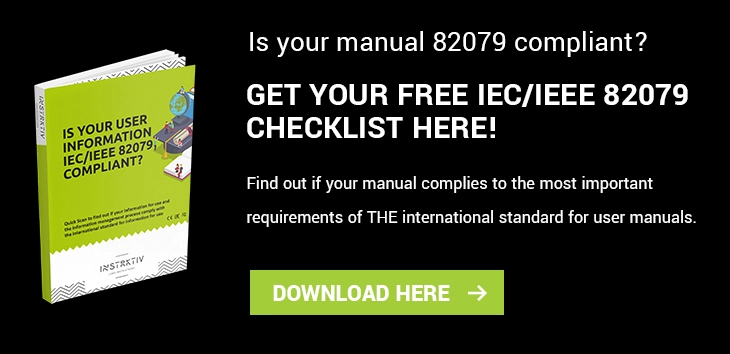
The EN 82079-1 in a Nutshell
So what is this 82079 standard all about?
The official name is ‘IEC/IEEE 82079-1:2019 Preparation of information for use (instructions for use) of products -- Part 1: Principles and general requirements’.
The standard mentions the purpose of information for use:
“Information for use shall provide the necessary information for the target audiences to make safe, efficient, and effective use of a supported product”
It is the successor to the IEC 82079-1:2012 Preparation of instructions for use -- Structuring, content and presentation -- Part 1: General principles and detailed requirements. And that one is the successor of the 62079 standard.
The standard has been developed by 2 convenors and 23 members from 9 countries. Therefore it has broad international consensus.
Compared to its predecessor, it contains major updates that I will discuss later.
It’s important to mention that it is a so-called horizontal standard: it does not apply to just a specific product or sector, but contains rules across sectors for almost all branches of the industry, from toys to medical devices and from electrical equipment to machinery.
The standard gives requirements on the content, structure, quality, process, media and format of information for use.
Information for use is considered as an integral part of the supported product.
The content for ‘information for use’ is comprised of information based on three pillars: instructional information, conceptual information and reference information.
The information for use may include various information products that are selected, presented, and delivered in different media to meet the needs of different target audiences.
The concept of information for use according to the standard:
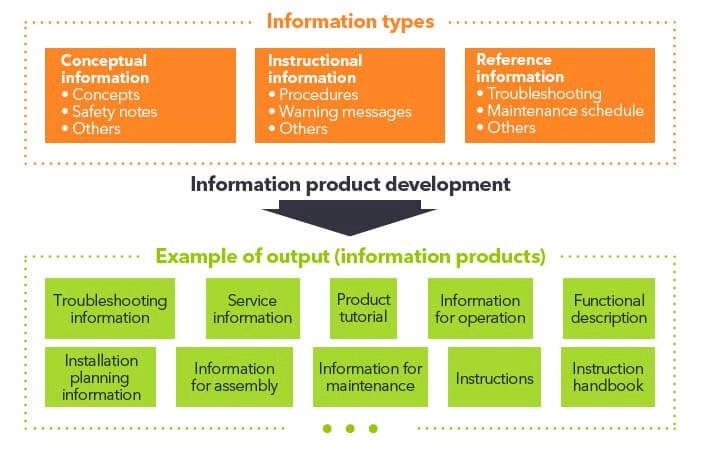
What is new in the EN 82079-1:2019?
First of all, as you might have noticed, there is a change of title.
In the new title, ‘information for use’ is used instead of ‘instructions for use’ and the IEEE has been added as the co-veloped the standard with IEC.
So why does the standard use “information for use” instead of “instructions for use”.
Information for use is used to indicate that content covers more than instructions/activities or operations to be performed. Instructions for use was also comprised of information describing the product, or reference material.
That’s why ‘instructions’ was always too limited and kind of misleading. The content for ‘information for use’ was comprised of information based on three pillars: Instructional information, Conceptual information, Reference information.
Next, the standard’s requirements are divided into requirements for information for use and requirements for the information management process. It includes a separate clause with requirements for the information management process. This clause does not apply to consumer products.
Also, the new standard describes clearly how to claim compliance, with both the requirements for information for use and with the requirements for the information management process.
How conformity assessment for the information for use and the information management process needs to be followed in order to claim compliance is given.
A new clause on ‘structure of information for use’ is included. It contains a complete new setup compared to the former standard. It emphasizes the use of leading criteria for structuring.
Another new clause is the ‘media and format of information for use“. This is also a complete new setup compared to the former standard. It covers the former section ‘presentation of instructions for use’ and more.
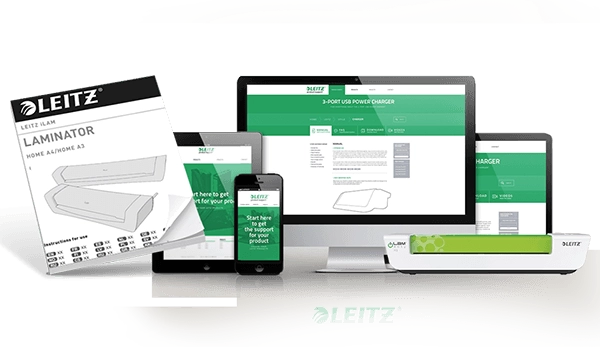
Information for use in different formats and media
The new standard includes a new clause named “professional competencies,“ which tells us that the creation of information for use shall be assigned to competent persons and even gives clear requirements on the proficiency level. It also includes the competencies of translators.
When it comes to usability, there is an integration of the principles of minimalism. Minimalism is a use-centered design philosophy. Its priority lies in supporting the usage of a product.
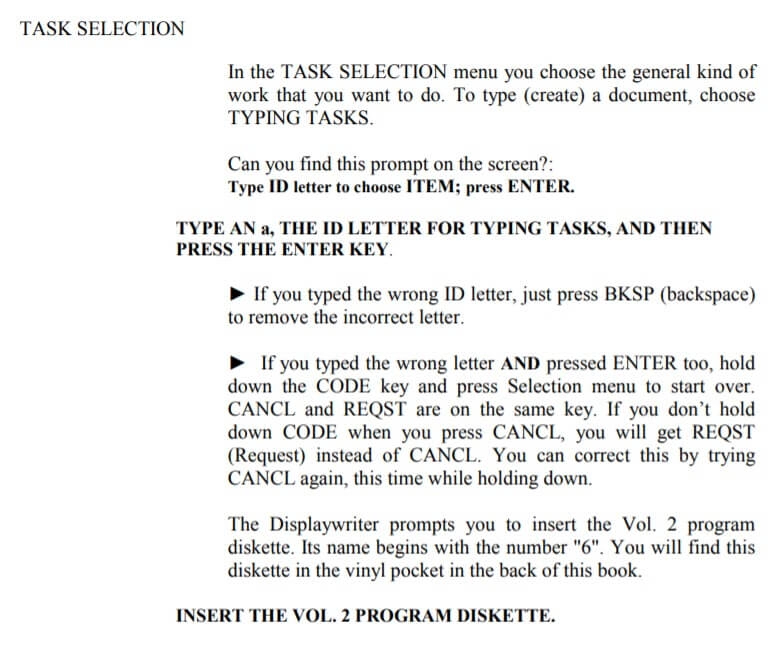
Example of instruction according to the Minimalism principles
The last major change is the division of information for use into three information types. This is in order to make safe, efficient, and effective use of a supported product possible, according to the standard.
These information types are comprised of conceptual information that the target audience needs to understand, instructional information to be followed or considered, and reference information to be consulted when needed.
Conceptual information includes concepts, explanations and descriptions that enable the target audiences to perform tasks by understanding their purpose and the principles of operation of the supported product.
Instructional information includes procedures and task-oriented step-by-step instructions.
Reference information: detailed information which needs to be retrieved occasionally, such as troubleshooting information, commands or codes.
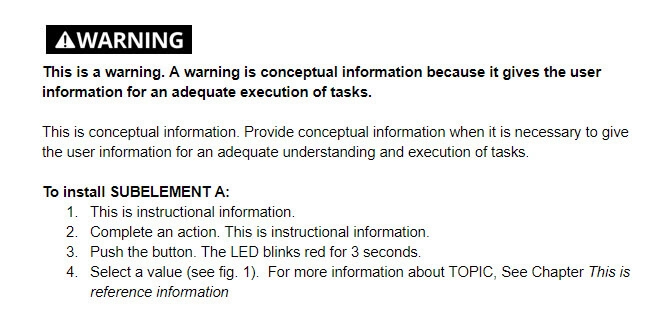
Three information types
How to write for usability according to the 82079 standard
According to 82079 standard , information for use shall provide the necessary information for the target audiences to make safe, efficient, and effective USE of a product. The standard, basically, is all about usability.
One of the main enhancements of 82079 standard is the implementation of the principles of minimalism.
Minimalism principles adapt to the audience as much as possible. The principles and heuristics of minimalism are not rules to be followed blindly or rigorously. They “merely” afford better designs.
The four main design principles of minimalism are:
- Choose an action-oriented approach. Users typically want to do things. This principle reflects the use-centeredness of minimalism
- Anchor the tool in the task domain. A tool is a means to an end. This principle asks designers to select training tasks that are meaningful for the user.
- Support error recognition and recovery. To err is human. There are several ways to increase user competence and comfort levels in handling mistakes.
- Support reading to do, study and locate. Designs must fit as much as possible the diverging needs and propensities of the intended audience. This principle reflects the user-centeredness of minimalism.
Some of the most important requirements on usability that you find throughout the 82079 standard to help you write user-friendly information are as follows:
- Make sure the information for use is usable and relevant for the target audiences with respect to their expected tasks and goals.
- Your Information for use should meets the target audiences' needs for information quality by being complete,correct, concise, consistent, comprehensible, accessible and that it applies the principles of minimalism.
- Use consistent terminology.
- List and explain unavoidable acronyms, abbreviations and technical terms.
- Make sure that information for use is easily searchable, contains convenient navigation and unambiguous content.
- Include predefined information types.
- Use consistent formatting.
- Include navigation, such as page numbering or a table of contents.
- Use text fonts, safety signs and graphical symbols that are clearly legible for the target audiences, both for print and electronic media (recommended minimum text font sizes and heights of safety signs and graphical symbols are listed in a table that is included in the standard).
- Base the media and format of the information for use on the needs of the target audiences.
What content to include according to the EN 82079-1 standard
The 82079 standard states that ‘the content of the information for use shall cover the needs of the target audiences for the safe, effective and efficient use of the product, applying the principle of minimalism.’
So why do we see the use of minimalism again? This is because the developers of the standard generally agreed that the use of minimalism helps the target audiences best to avoid unacceptable safety risks, malfunction of or damage to the supported product, or inefficient operation.
Also, the 82079 standard emphasized that both the intended use of the product and the reasonably foreseeable misuse should be included.
Further, the 82079 standard mentions including the following information in your information for use:
- Identification of the information for use, the supported product and the supplier
- Information regarding retaining the information.
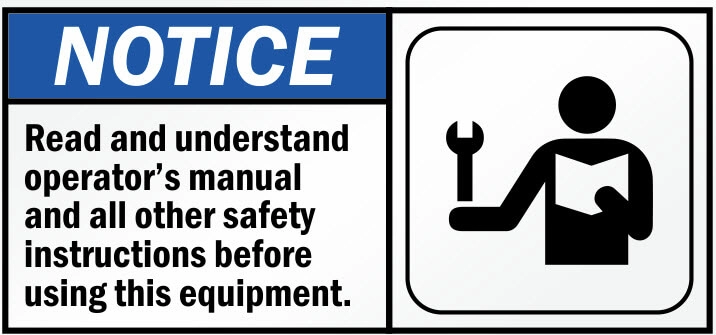
- Presentational conventions. For example, the use of a particular typeface for text to be entered by the user, keyboard keys, or menu items. The conventions can best be listed and their meaning explained.
- Explanation of terminology. Also, if the information for use of a complex system contains several documents from more than one supplier, you should explain the meaning of the different terms used.
- Explanation of abbreviations, technical terms, safety signs, graphical symbols and markings.
- Safety related information such as safety signs and product safety labels, safety notes and warning messages.
- Signal words for warning messages for harm to persons (DANGER, WARNING, CAUTION) or damage to property NOTICE, BEWARE, TAKE CARE).
- Repacking information.
- Transportation and storage information.
- Installation information.
- Commissioning information.
- Modification information and/or restrictions.
- Operation information.
- Information on exceptional and emergency situations.
- All information needed during the life cycle of the supported product such as information on maintenance, replacement of parts, repair and troubleshooting.

Example of explanation of presentational conventions
This video explains how to determine the full content that should be included in your user instructions:
DO YOU WANT TO CHECK IF YOUR DOCUMENTATION COMPLIES?
We can check if your technical documentation and manuals comply with the IEC/IEEE 82079-1:2019 standard and the European Directives.
How to structure your information according to the EN 82079-1 standard
The 82079 standard emphasises that it is important to structure information for use for the sake of usability and comprehensibility.
Features can be included for easy search, navigation and unambiguous understanding of the contents.
If the information for use is intended for different target audiences, such as installers, operators or maintenance technicians, the information for use should be separated into chapters or sections.
Information for use should be allocated in its functional structure to predefined information types that include conceptual information, instructional information and reference information.
Conceptual information includes the following information about the information for use itself: a description and identification of product and components, a description of controls and displays, process description (use case or concept of operation) and directional safety notes.
Instructional information includes step-by-step procedures and a warning message as part of the procedures.

Example of an instruction with an embedded safety message
Reference information includes title page information, legally required information, troubleshooting information, a maintenance schedule, the table of contents, a glossary and an index.
A structuring method/information model should be used to structure information.
The standard also says that information can be structured around so called leading criteria, such as tasks, the product life cycle, target audience and the product’s functions.
In order to do so, tasks can be structured by the order in which tasks are performed.
When structured around the life cycle of the product, the product’s life cycle stages, such as transporting, installing, commissioning, operating, servicing, repairing and disposing, can be used.
Further, to structure your information, you should take the following into account:
- Include preliminary information, instructional steps, and completion information in step-by-step instructions.
- For printed information for use, include page numbering (if more than two pages), a table of contents (if more than 12 pages) and an index.
- In case of dynamic delivery, include individualized delivery, context sensitivity, search functions and links to related topics.
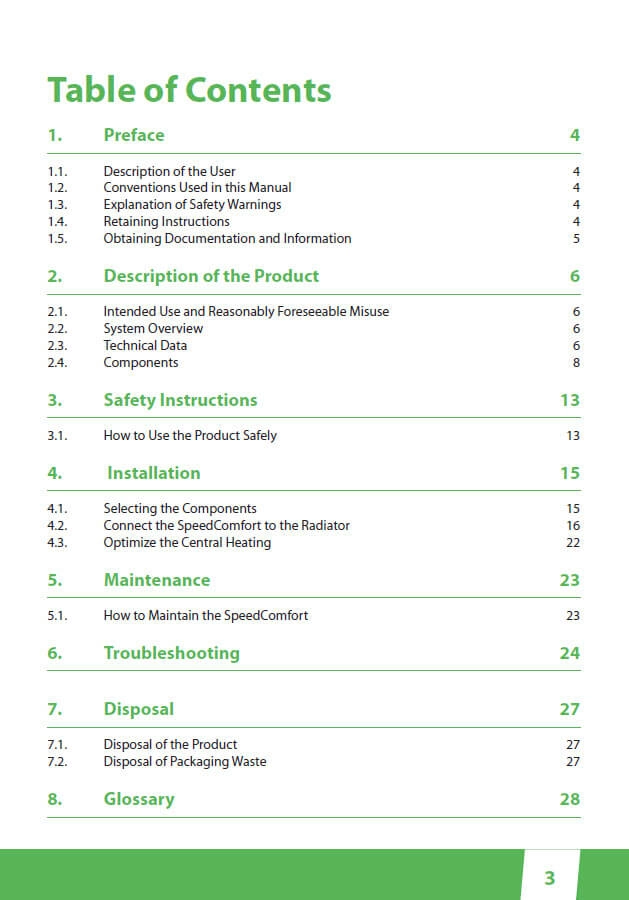
Example of how Information for Use can be structured by the several stages of the product life cycle
How to format and present your information for use
The 82079 standard has become less strict when it comes to the media and format of the information for use and should be based on the needs of the target audiences.
It is considered important that the media allows easy and permanent access to information for use and that the chosen media are durable.
It is important to address the conditions of use when choosing the media and format. For example, in the case of low light, the medium should light up the text and speech should not be used in a noisy environment. Paper should not be used on wet environments or clean rooms.

Paper Information for use is not desired in clean rooms
Depending on the needs of the target audience, information for use can be provided inside the packaging, on or within the product; on the packaging (but not only on the packaging), on websites or as separately provided in collateral documentation.
The following are important things to consider when formatting and presenting your information for use:
- Design the pages of printable information so that they are legible.
- Make sure that downloadable information can be displayed on commonly used devices.
- Make sure that text fonts, safety signs and graphical symbols are clearly legible and follow the recommended minimum sizes.
- Maximise brightness contrast.
- Comply graphical symbols with international standards.
- Clear illustrations are used to enhance text.
- Tables are clear, informative and have a consistent design.
- Colours are only used to draw attention to particular sections of information.
- Icons are clear and used unambiguously.
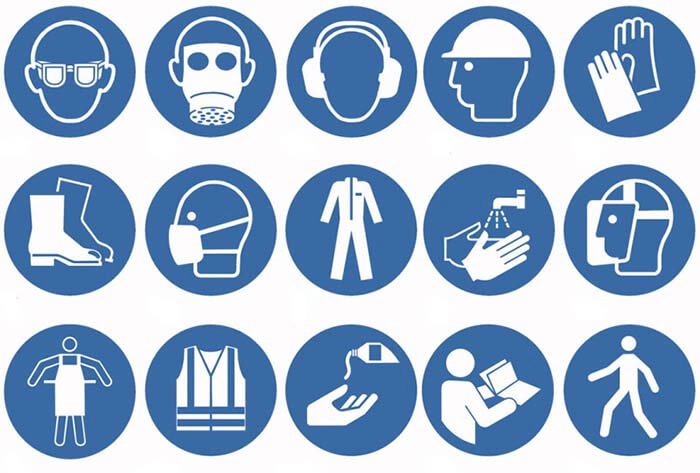
Examples of clear icons according to ISO 7010
How to write safe instructions according to the EN 82079-1 standard
Let’s repeat the purpose of the 82079 standard again:
The standard’s goal is to give requirements to ensure that information for use provides the necessary information for target audiences to make SAFE, efficient, and effective use of a product.
As you might guess, I want to go into further detail regarding the safety aspects of the standard.
Many of the requirements in the standards are safety related.
As mentioned earlier, the 82079 standard emphasises that the intended use of the product should be included.
The standard defines the intended use as an ‘exhaustive range of functions or foreseen applications defined and designed by the supplier of the product’.
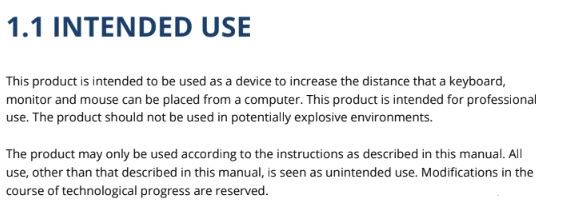
Example of the description of the intended use of a product
The intended use is a safety aspect, as it sets out the liability of a manufacturer and affects the further contents of the manual.
Once the intended use has been described clearly, mostly somewhere in the beginning of the user instructions, the rest of the (safety) instructions can focus on those related to the intended use only.
Information for use should promote the safe installation, operation, maintenance etc of the supported product within the boundaries of the intended use.
Besides the intended use, a description of the reasonably foreseeable misuse should be included.
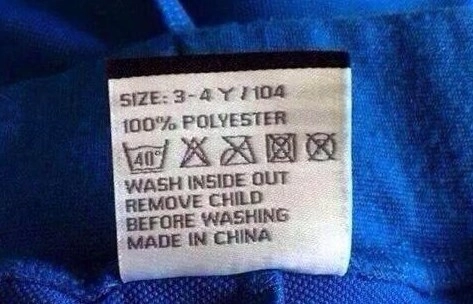
Example of reasonably foreseeable misuse?
Another aspect in order to write safe information for use is to include a list of the supplied accessories, consumables and spare parts.
This is important because you want to direct your user to what parts to use within the technical lifespan of your product.
Also provide information on the replacement of parts of the supported product by both non-skilled and skilled persons.
Further, to write safe information for use, make sure you include the following:
- Information for identification of the product.
- Information about the importance of retaining printed information for use.
- An explanation of safety signs, graphical symbols, pictograms, and markings placed on the supported product and packaging.
- Directions where legal requirements, safety, or technical reasons prohibit the installation, operation, or maintenance of the supported product by non-skilled persons. The qualifications, competencies, and skills required are clearly stated in the information for use.
- Information on the maintenance of the supported product by non-skilled and skilled persons.
- Information on indications of faults and warning device signals of the supported product.
- Maintenance and service procedures of complex systems.
- Information on troubleshooting and repair of the supported product by non-skilled and skilled persons (necessary to guarantee that the product can be used safely after reparation).
- Safety-related information, such as safety signs, safety notes and warning messages (the design of the warning messages must be consistent)
- Precautions for particular target audiences such as children or older persons.
- Signal words for harm to persons or to damage property, such as WARNING, CAUTION, DANGER or NOTICE)
- Information regarding security and data privacy.
- If applicable, a specification of the training is required for the target audiences.
Attention must be attracted to safety-related information and warning messages must be durable and visible.
However, if warning messages are integrated between the steps of a procedure, the formatting of the warning message should not distract the user from reading the information!

Use of signal words in information for use
How should the Information Management Process look like?
The standard’s requirements are divided into the requirements for the information for use and the requirements for the information management process.
Clause 6 of the 82079 standard contains the requirements for the information management process. This clause does not apply to consumer products. Why not?
Most likely because the members of the committee agreed that this would make the process of creating relatively simple user instructions too complex for this type of product.
For all other products, the supplier must implement information management processes for the planning, designing, producing, and sustaining of information for use. Therefore, the following four process groups are distinguished:
- analysis and planning of information
- design and development (including review, editing, and testing)
- production and distribution
- sustainment (including maintenance and improvement)
Regarding the analysis and planning of information, the standard states that instructional procedures have to be formulated based on:
- a market analysis, or
- an analysis of the characteristics, needs and intended tasks of the target audiences.
This analysis can include, but is not limited to, an analysis of the target audience (e.g. background, skills, experience, language, tasks, working environment and available tools), media, information sources, risk management, contractual agreements and legal considerations.
The development process must include, for example, preparation of information design concepts, preparation of templates, information gathering, selection of a content structure; editing and reviewing the content and usability testing.
The production and distribution process must include the integration, preparation, reproduction, packaging and distribution of physical media or electronic copies of the information for use.
And lastly, the sustainment, maintenance and improvement process includes continuing target audience feedback and the establishment of a method for receiving information on changes, updating and making these updates available.
Further, in order to comply with the 82079 standard, ask yourself the following questions::
- Are repeatable information management processes used?
- Does the use of repeatable processes facilitate planning, implementing, checking, correcting, and improving the information for use?
- Are these processes planned so as to obtain sufficient competent human resources for information development and to make information accessible at the required time?
- Are these processes quality managed and assured on the basis of clear and common quality objectives?
- Do these processes use single-source information management to reduce inconsistencies and discrepancies?
- Is information content retained for reuse throughout the intended lifetime of the supported product, maintained to be current, and adaptable for use on similar products and future product versions?
- Does the information management process generate, obtain, confirm, transform, retain, retrieve, and disseminate information, as appropriate?
- Does the information management identify information to be managed, define information representations, obtain, develop or transform, store, validate, present, and dispose of information, identify the status of information and make information available for use?
What skills are required according to the EN 82079-1 standard?
The 82079 standard mentions that skills, responsibilities and competencies of the persons involved in the information development process are crucial for the quality of information for use.
The concerning clause states that:
“The creation of information for use shall be assigned to competent persons. Organizations should analyse their content creation process, identify the tasks to be performed to achieve the required results, evaluate the competencies which are needed to perform these tasks successfully and finally designate the tasks and responsibilities to persons who cover these competencies. Responsibilities should be assigned to separate persons where the size of the organization permits.”
These competency requirements have been described in much more detail in the new standard than they were in the former one.
There are three levels of proficiency indicated:
Level 1 responsibilities include the use and application of relevant standards to define the information structure and to develop or update information.
Level 2 responsibilities include the ability to determine the requirements for the information products taking into account the purpose and domain to which they apply.
Level 3 responsibilities include the ability to manage the process of information creation, develop content strategies, take over responsibility of standard conformity, and to lead information development teams.
All competency requirements apply to both the persons that prepare the information for use and the competencies of translators as well.
Competent translators or language specialists are responsible for the translation, including checking and proofreading.
The translators should have basic competencies as stated in proficiency level 1, should be fluent as well in the original as in the target language, should be native speakers in the target language and should be familiar with the type of product and any product-specific terminology.
Where to download the EN 82079-1 standard checklist
When you are unsure whether your user instructions comply with the new standard, use our quick scan to find out if your information for use complies with some of the most important requirements.
The checklist can be downloaded here:
Please note that this is not a complete checklist. In order to comply, use the full standard.
How to create information for use that complies with the EN 82079-1 standard
To implement the requirements from the 82079 standard, there are basically two main routes you can follow.
First of all you can purchase the standard and have the information for use created by a competent person.
The other option is to download one of our templates. These user manual templates are MS Word templates that contain all mandatory elements to create your own user instructions.
You can use the template to create instructions that comply with the CE marking requirements, the Machinery Directive, the EN 82079 standard and the ANSI Z535.6 for Safety Messages.
How to claim compliance with the IEC 82079
Some companies want to claim that their information for use complies with the 82079 standard. A claim for fulfilling the requirements can be made for:
- the information for use supporting a particular product by fulfilling the requirements of sections 5.2, 5.3, 7, 8 and 9
- the information management process by fulfilling the requirements of sections 5.4, 6 and 10.
In order to evaluate the fulfilment of the requirements, the standard states that for fulfilment of requirements with regards to the information for use, a comprehensiveness check, an inspection for effectiveness (desk check) and empirical effectiveness check should be used.
For fulfilment of requirements with regards to the information management process, a process assessment and competency assessment should be conducted..
This means that for the information for use, you should, amongst others, make sure that:
- fulfilment of the requirements of Clause 7 has been assessed by a suitably qualified and experienced person conducting a comprehensiveness check to assess whether or not the required content has been included in the information for use.
- fulfilment of the requirements of Clause 8 and 9 for structure, media and format of information for use is evaluated/inspected for effectiveness by a suitably qualified and experienced person via a desk check.
- the empirical effectiveness involves not only skilled experts but also persons unfamiliar with the use of the supported product and its information for use.
It also means that for the information management process, you should, amongst others, make sure that:
- the information is evaluated to determine if residual risks from the product risk assessment have been addressed (e.g. does the information for use include appropriate warnings for hazards?).
- information for use conforms to the relevant product-specific safety standard(s).
- a separate legal check has been conducted.
- the results of the evaluation are documented and the supplier retains records.
- where fulfillment of requirements in this document is claimed, the supplier does retain records.
Conclusion
Well, there is a lot to say about the 82079 standard as you can see, and I have only covered the most important aspects.
I think it is a great standard and by applying it, you don’t just create compliant information for use.
Your instructions will be incredibly user-friendly as well and your audience will simply love using your product with them.
So, dive into it and create awesome instructions!
If you found that this post was helpful to you, I would appreciate it if you could leave a comment below or contact me for any inquiries.
 |
Ferry Vermeulen is a technical communication expert and director at INSTRKTIV. It's Ferry’s mission to create digital user instructions for all products in the world. Listen to the INSTRKTIV podcast on Spotify or read one of his latest blog articles. Linkedin I Spotify I YouTube I Facebook I Twitter |
DO YOU WANT A USER MANUAL TEMPLATE THAT ALREADY CONTAINS THE LEGAL PARTS?
Take the shortest way to a compliant manual. We have developed user manual templates for machinery, toys, medical devices and electronics that contain all legal content.

